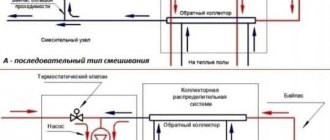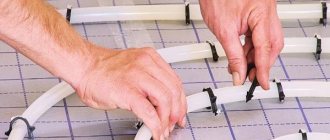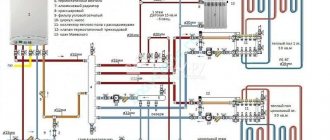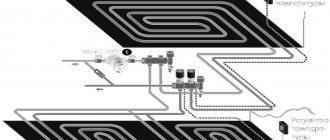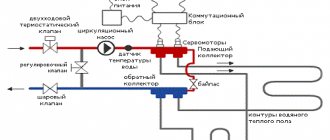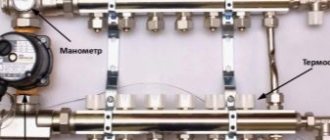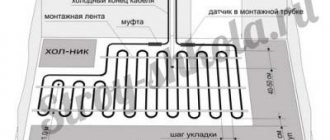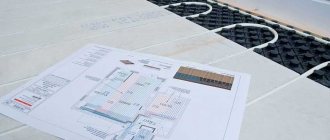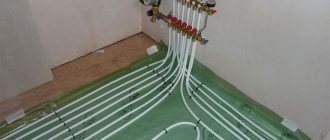The installation of a water heated floor is impossible without installing a special device - a collector. You can build it yourself using improvised means. But it is more efficient to install a ready-made collector group, which is sold fully assembled with all components.
Heated floor collector unit
Purpose
The collector unit is an important element of a water heated floor, which is designed to distribute coolant in the heating system. Thanks to the special design, hot and cold liquids are mixed inside this unit. This feature allows you to adjust the temperature of the heated floor and control its operation.
Valtec manifold assembly design for heated floors
The collector unit operates thanks to the circulation of the coolant. The heated liquid enters the heated floor, where it cools and returns back to be heated.
During operation of the device, circulating substances at different temperatures are mixed to achieve optimal characteristics. This process is controlled using several additional elements - various sensors, valves and others.
A manifold group with a pump is the most efficient. The coolant circulates through the water circuit using a forced method.
Connection diagram of the collector unit to the heated floor
This allows you to obtain productive floor-type heating, which is installed in rooms with a large area. To install a heated floor with natural circulation, it is necessary to ensure that there is an optimal slope, which can be quite difficult.
Manifold cabinet
For those whose heating equipment is located in a separate room, this element may not be needed. But for everyone else, it’s advisable to hide all the elements - a bunch of pipes, a pump, a manifold - somewhere. For this purpose, there are special manifold cabinets (also called distribution cabinets) - metal products with a door, which often already have mounting hardware.
Manifold cabinet. An optional detail, but very convenient to hide all devices in it
Manifold cabinets can be external (SHR) and built-in (SHRV). Side panels are often perforated, making it easy to make holes where needed. Many models have adjustable legs that allow you to change their height. Built-in manifold cabinets can also change in depth due to a movable frame. To determine the size of the manifold cabinet, you need to know the mounting dimensions of all the equipment that you will need to place there. Also decide on the direction in which the door will open. There are models with a removable door, some people will like them.
The cabinets are attached to the floor through the legs, or to the wall through the back wall (there are special holes). Built-in modifications also have spacer fasteners that can be used to secure the box in a niche.
This is what it might look like with a collector
If we talk about the material from which the cabinets are made, it is galvanized, powder-coated. In general, the equipment looks decent, and even in a living room it won’t ruin the view. When purchasing, naturally, pay attention to the uniformity of paint application and the thickness of the metal. Although the mechanical loads are small, the walls should not be too thin. This is especially true for external manifold cabinets.
And this is how you can embed it
An example of installing an Uponor plastic manifold in a manifold cabinet is captured in this video.
Device with 2-way supply valves
The two-valve manifold assembly has the following features:
Two-valve manifold assembly kit
- cold and hot coolant are constantly mixed. This prevents overheating of the device and extends its service life;
- the temperature change occurs smoothly, since 2-way valves have a small throughput;
- are not used in small rooms whose area is less than 200 square meters. m.
Device with 3-way mixing valves
The three-valve manifold assembly is a design with the following characteristics:
- mixing of liquids with different temperatures occurs inside the valve;
Structure of a three-valve manifold - simultaneous supply of heated coolant from the boiler and liquid from the floor heating through the bypass is carried out;
- To regulate operation, a damper is placed inside the valve. It is installed perpendicular to the supply and return pipes. By changing its position, you can adjust the temperature of the coolant supplied to the floor heating;
- The disadvantage of this type of design is considered to be the presence of temperature surges. The advantage of 3-way valves is their versatility, as they are suitable for all types of water circuits.
Advantages of using collectors as part of underfloor heating
Devices that are installed assembled with all additional elements provide the following advantages:
How to assemble a manifold for a heated floor
- energy savings compared to traditional heating systems (on average 30-50%);
- high safety due to the absence of open elements that could become a source of fire hazard;
- The duration of operation of the collector group is several decades. Only pipelines are subject to periodic replacement;
- Optimal microclimate parameters in the heated room are ensured.
How to choose a manifold for heated floors
The main parameter for choosing a manifold for a heated floor is the number of circuits to be connected.
Expert opinion
Sergey Permyakov
Heating systems engineer
We recommend purchasing a comb with a reserve of one output, in case it becomes necessary to split an overly long circuit into two branches or connect additional monitoring equipment (thermometer, pressure gauge).
The second selection criterion is the material used to make the comb body. Reliable products are manifolds made of brass or stainless steel, as well as bronze, manufactured in accordance with domestic GOSTs or European quality standards. “Chinese” ones made from dubious alloys can be purchased only after the seller demonstrates a certificate of conformity, and the comb itself has been thoroughly examined for cavities, cracks or traces of corrosion.
Although in fact most modern products, if not all those on the market, are produced by Chinese enterprises, when choosing them, preference should be given to well-known brand names. After all, reputable European companies carefully monitor the quality of work of their production facilities, even those located in the Middle Kingdom.
First of all, pay attention to products under the brands: Rehau, Kermi, Valliant, Valtec, FIV, Rossini. It is best to purchase a manifold for underfloor heating from such companies as a complete set. Purchasing individual elements will cost more, and components from other manufacturers may be incompatible with installation parameters.
Device installation
The manifold for a warm water floor is mounted according to the following scheme:
- It is necessary to install a frame under the device. It is mounted directly on the wall in a horizontal position or in a specially prepared niche. When choosing a location for installation, you should be guided by the availability of free access to the device to connect the required number of pipelines. Also, a special cabinet is often used to mount the device. In this form, the device can fit into any room.
Diagram of a collector unit in a heated floor system - Connection to the heating boiler. The coolant is supplied to the system from below, and the return is placed at the top. You also need to install cut-off balls in front of the frame. A circulation pump is installed behind the taps.
- The bypass valve is being installed. It must be equipped with a temperature limiter. Behind this unit the distribution comb is installed.
- Pipelines are being laid to the heated floor. The elements through which coolant will flow into the system are placed on top. Pipelines from underfloor heating are installed from below.
Connection diagram of the heated floor collector to the boiler - If you intend to install the device yourself, you must connect shut-off valves that are equipped with a thermostat to the distribution comb. When installing a ready-made kit, this is not necessary.
- The collector is connected to the heating system using compression fittings. This element consists of a clamping ring, a support sleeve and an intermediate nut.
- Pressure testing of the collector. After installing all structural elements, it is necessary to check how tight the resulting system is. To do this, the unit is connected to a circulation pump. With its help, pressure is built up in the system. The water circuit is left in this form for a day. After this time, the pressure is checked. If it has not changed, then the installation was successful.
The principle of operation of the device in the assembly
There are several working schemes for assembling a distribution unit, but the operating principle of the device remains virtually unchanged. Let's consider one of the standard assembly options, in which the manifold for a heated floor is equipped with:
- Shut-off valves for the distribution manifold and return.
- Taps for draining the working medium from the supply and return lines.
- Three way valve.
- Circulation pump.
- Pressure gauge.
- Flow meters for each circuit.
- Manual control valves for each circuit.
Tips from the professionals
When installing this device, you should pay attention to the following recommendations:
Dimensions of a wall-mounted cabinet for a manifold unit
- the thickness of the collector box must correspond to the dimensions of the unit;
- You must remember to leave free space for bending pipes from each installed circuit. It must be provided directly under the block;
- The device box is placed at a point that is at the same distance from all contours.
If you use a ready-made collector group, you can significantly simplify the installation of this device. It is very easy to install it yourself without the help of specialists.
Assembly and installation
It is recommended to install a cabinet with a manifold block in such a way that the heated floor loops are approximately the same length. If the distribution device is located above the level of the heating circuit, air from the system will be automatically removed through the air vent. In the case where the cabinet is planned to be hidden in the basement or placed on the floor below, you will have to install an air vent on each circuit, complete with a ball shut-off valve, as well as on the return line.
When assembling the collector block, pay attention to the tightness of the connections. If the equipment does not come with rubber sealing rings, the threads are sealed by winding.
Next, the underfloor heating manifold is installed in a special cabinet. The guides, equipped with bolts and nuts for fastening the combs, are moved in accordance with their length. If the collector block is mounted without a cabinet, use clamps with dowels or brackets. At the same stage, if necessary, a mixing unit is installed and a circulation pump for the heated floor is installed. Finally, the circuits are connected and the system is tested.
